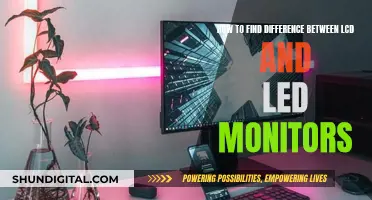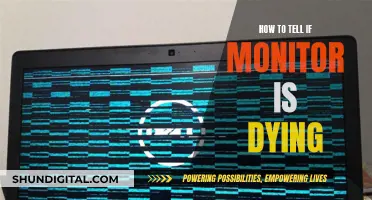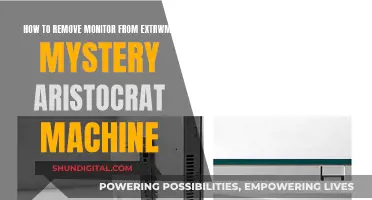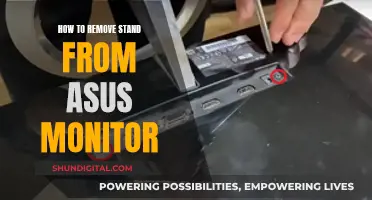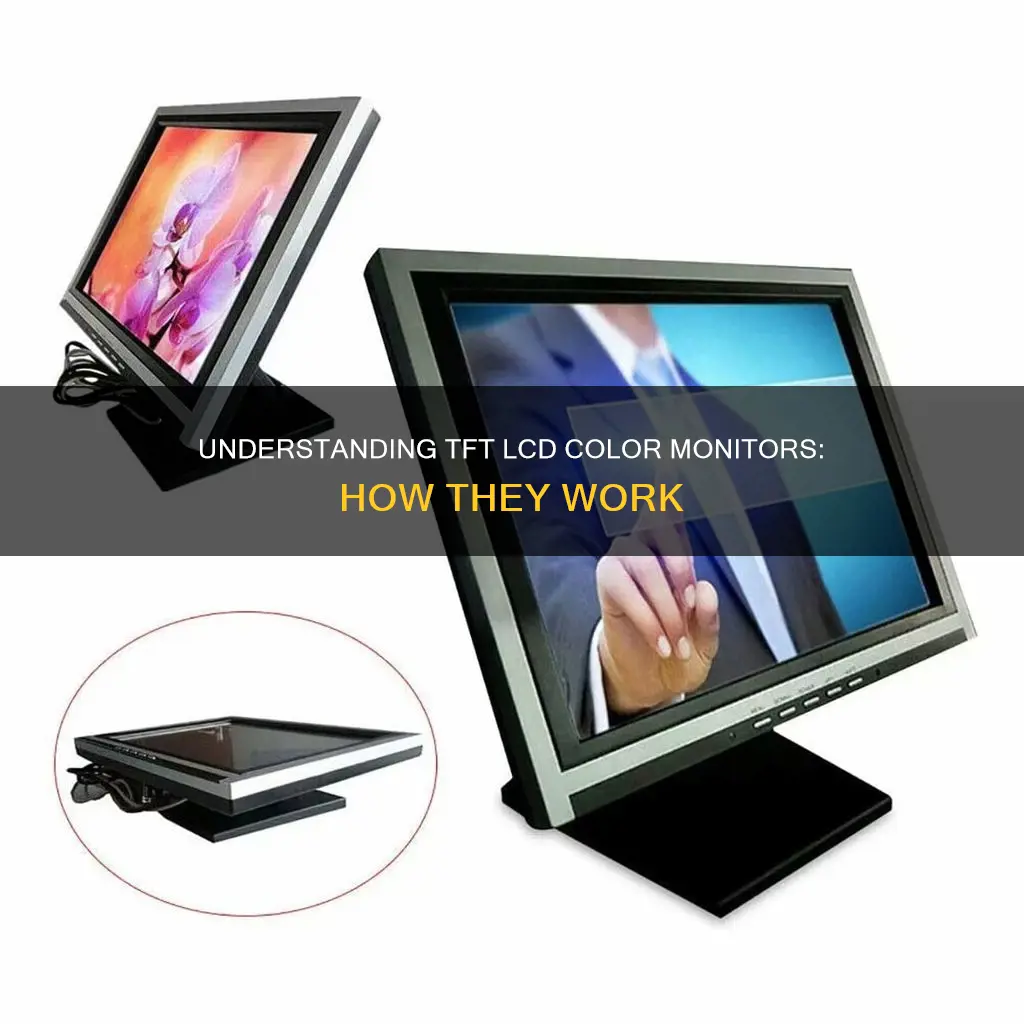
A TFT LCD colour monitor is a thin-film transistor monitor that uses LCD (liquid crystal display) technology. This means that each pixel on the display has its own transistor, allowing the screen to refresh quickly as the image is repainted several times per second. TFT LCD monitors are commonly used as rear-view monitors in vehicles, as well as for computers and televisions, replacing the old-style cathode ray tube (CRT) monitors. They are known for delivering crisp text, vibrant colours, and improved response times, making them suitable for gaming, video editing, and other multimedia applications.
What You'll Learn

TFT LCD monitors are used in vehicles as rear-view cameras
A thin-film-transistor liquid-crystal display (TFT LCD) monitor is a type of display that uses a thin-film transistor and liquid crystals to display images. These monitors are often used in vehicles as rear-view cameras, providing drivers with a clear and convenient view of what's behind their car.
TFT LCD monitors offer several advantages for this application. Firstly, they are relatively inexpensive, making them an affordable option for enhancing driving safety. Secondly, they often come in a range of sizes, from 5 to 10 inches, allowing drivers to choose a screen that fits their vehicle and personal preferences. Additionally, these monitors usually have a wide field of view, typically offering at least 90 degrees of visibility, which is crucial for safely backing up and parking.
When choosing a TFT LCD monitor for a rear-view camera, it's important to consider the image sensor size and type, as well as the lens focal length, to ensure a clear and wide-angle view. The bigger the sensor, the better the picture quality, especially in low-light conditions. It's also worth noting that while some larger sensors can provide up to 210-degree views, they may also create a fisheye effect that distorts the image and makes it impractical for reversing.
In addition to the monitor itself, the camera's mounting type is another important consideration. Surface-mounted cameras are typically installed on any flat surface, often positioned high up to provide an improved rear view and perception of depth. Flush-mounted cameras, on the other hand, are installed through a hole in the vehicle's body and sit level with the road, offering a clean look. Finally, license-mounted backup cameras are mounted on the license plate for easy installation, but they may not provide a centred view if the plate is off-centre.
Monitoring Plex Usage: A Comprehensive Guide to Tracking Activity
You may want to see also

TFT LCD monitors can be used with DVD players, VCRs, and video game consoles
TFT LCD monitors offer excellent colour display, with top-notch colour contrast, clarity, and brightness settings that can be adjusted to meet specific requirements. They also have a much higher half-life than LED monitors and come in a variety of size configurations.
TFT LCD monitors are highly versatile and offer a range of interface options that are compatible with various devices. They can be used with DVD players, VCRs, and video game consoles, as well as with computers and other video equipment. For example, a 7-inch TFT LCD monitor can be used as a car rearview camera monitor and connected to a car DVD player or VCR.
TFT LCD monitors have fast and accurate response times, minimise eye strain, and are space-efficient due to their rotational mount design. However, they are typically more expensive than other displays, have disproportionate viewing angles, and rely on backlighting for brightness.
Monitoring ChatGPT Usage: Strategies for Tracking Activity and Performance
You may want to see also

TFT LCD monitors can be connected to GPS devices
A thin-film-transistor liquid-crystal display (TFT LCD) is a type of liquid-crystal display that uses thin-film-transistor technology to improve image qualities such as addressability and contrast. TFT LCDs are used in television sets, computer monitors, mobile phones, video game systems, personal digital assistants, navigation systems, projectors, and dashboards in some automobiles and in medium to high-end motorcycles.
To connect a discrete controller to an LCD panel, you will need an oscilloscope. The first step is to find the datasheet for the LCD controller chip, which will allow you to reverse engineer your module. Once you have the datasheet, you can figure out how to interface with the LCD controller, which will either be a parallel or serial connection. Then, connect your microprocessor to the data and control lines and test the communication. Finally, write the drivers for the LCD.
Monitoring Marijuana Usage: A Comprehensive American Overview
You may want to see also

TFT LCD monitors can be used as computer displays
TFT LCD monitors are ideal for use as computer displays. TFT stands for thin-film transistor, and this technology is used in LCD (liquid crystal display) screens. LCD monitors are also known as flat-panel displays, and they have replaced old-style cathode ray tube (CRT) screens in both televisions and computer displays.
The advantage of TFT technology is that each pixel on the display has its own tiny transistor. Because each transistor is so small, it requires only a small amount of charge to control it. This enables the screen to refresh very quickly, repainting the image several times per second. This means that TFT monitors can easily track a mouse being dragged across the screen, for example, whereas passive matrix LCD displays struggled to keep up with fast-moving images.
TFT LCD monitors deliver crisp text, vibrant colours, and improved response times, making them ideal for gaming, video editing, and other multimedia applications. When choosing a TFT monitor for gaming or multimedia purposes, look for a response rate of 16ms or less.
TFT LCD monitors are widely available in sizes suitable for computer displays, such as 7, 15, and 17 inches. They are also affordable, with many options available at a low cost.
Monitoring Your Child's iPhone: A Parent's Guide
You may want to see also

TFT LCD monitors can be used for video surveillance
A Thin-Film-Transistor Liquid Crystal Display (TFT LCD) monitor is a type of flat-panel display screen that uses a liquid crystal layer modulated by a grid of thin-film transistors. They are commonly used in televisions, computer monitors, and mobile phones.
- TFT LCD monitors are typically thinner, lighter, and more compact than CRT monitors, making them easier to install and integrate into various environments for surveillance purposes.
- They offer improved image quality with higher resolutions, providing sharper and more detailed video feeds. This enhanced resolution allows for better identification of objects and individuals in the surveillance footage.
- TFT LCD monitors consume less power than CRT monitors, making them more energy-efficient and cost-effective for long-term surveillance applications.
- They produce less heat than CRT monitors, reducing the need for additional cooling systems and ensuring a more comfortable environment for security personnel.
- TFT LCD monitors typically have longer lifespans than CRT monitors, resulting in lower maintenance costs and reduced need for frequent replacements.
- Many TFT LCD monitors come with additional features such as built-in speakers, remote controls, and multiple input/output options (HDMI, VGA, BNC, etc.), making them versatile for various surveillance setups and allowing for a more comprehensive security system.
When selecting a TFT LCD monitor for video surveillance, it is important to consider factors such as screen size, resolution, connectivity options, and the number of inputs/outputs required to ensure compatibility with the surveillance system.
Wall Mounting Your ASUS: A Step-by-Step Guide
You may want to see also
Frequently asked questions
A TFT LCD monitor uses thin-film transistor technology in a liquid crystal display. TFT monitors have a separate, tiny transistor for each pixel on the display, allowing the screen to refresh very quickly.
The advantages of a TFT LCD monitor are that it can display fast-moving images without blurring or disappearing and it delivers crisp text, vibrant colors, and improved response times for multimedia applications.
One disadvantage of a TFT LCD monitor is that it may have "dead pixels" due to the failure of one or more transistors. Most manufacturers will not replace a monitor with fewer than 11 dead pixels, but these are usually not noticeable unless they are in a critical position on the screen.


